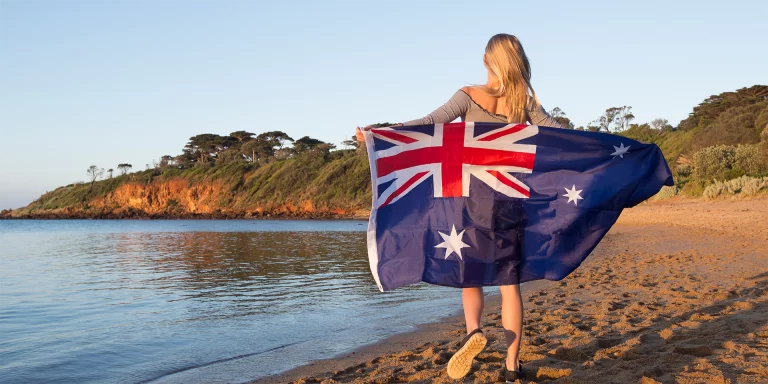Melbourne
- Cultural capital of Australia














QUOTE NOW
*Valid for payments before 31/11/2023, and contracted for a minimum of 24 weeks. Applies for courses in the morning hours.
SUMMARY
It is the second largest city on the Australian continent and is known for its vibrant cultural life, its varied gastronomic offer and its cosmopolitan atmosphere. It is also one of the safest and most pleasant cities to live in the world. Melbourne is the student city par excellence, with more than 500,000 students enrolled in its universities, colleges and vocational training centres. The city offers a wide range of educational courses and programs, from undergraduate and postgraduate levels to vocational training courses. In addition, it is also recognized for its multiculturalism, with more than 200 nationalities represented in its population. This makes it an ideal place to learn English and immerse yourself in the Ozzie lifestyle.
WHAT MAKES MELBOURNE A GREAT CITY TO STUDY?
- Quality of life: Melbourne has been ranked as one of the most liveable cities in the world for several years in a row. The city offers a high level of security, a first-class health system and a wide range of public and private services.
- Education: Melbourne is home to some of the world’s best universities, including the University of Melbourne, Monash University and RMIT. The city also offers a wide range of educational courses and programs, from English courses, undergraduate and postgraduate levels, to vocational training courses.
- Culture: Melbourne is a city with a vibrant cultural life. The city is home to a large number of museums, art galleries, theaters and concert halls. There are also a variety of cultural events taking place throughout the year, such as the Melbourne Festival, Melbourne Film Festival and Melbourne Arts Festival.
- Gastronomy: Melbourne is known for its varied gastronomic offer. The city has more than 4,000 restaurants offering cuisine from around the world. There are also a wide variety of markets and specialty shops where you can buy fresh produce and foods from around the world.
- Atmosphere: Melbourne is a very welcoming and friendly city. Melburnians are known for their hospitable spirit and willingness to help others.
IF YOU ARE LOOKING FOR A VIBRANT, SAFE AND COSMOPOLITAN CITY TO STUDY IN, MELBOURNE IS AN EXCELLENT CHOICE.
- PROS AND CONS
- WEATHER
- LOCATION
- WHAT TO VISIT?
- PUBLIC TRANSPORT
PROS
- It is a very cosmopolitan and diverse city, with a large population of Spanish speakers. This can be an advantage if you are looking for a city where you can maintain your mother tongue and practice your English.
- Melbourne has a high standard of living and an excellent quality of life. This means that you will have access to good education, health care, public transportation and other essential services.
- It is a very safe and friendly city. This will allow you to feel safe and comfortable living in the city.
- It has a great cultural and gastronomic offer. This means that you will have many options to explore Australian and world culture.
- Melbourne is a city very well served by public transport. This will allow you to easily move around the city and get to all your appointments.
CONS
- The weather can be unpredictable. Melbourne has a temperate climate, but it can be very changeable. It can be rainy, cold and sunny on the same day.
- Public transport can be overcrowded. Melbourne is a very large city and public transport can be overcrowded, especially during rush hour.
- Cost of living can be high. Melbourne is an expensive city, especially for accommodation. Renting a room in a shared house can cost between 200 and 300 Australian dollars per week.
- Distances: Although Melbourne is a large city, some tourist attractions and beaches may be a little further away, which may require more time and planning to explore the entire city.
Melbourne has a temperate oceanic climate, characterized by well-defined seasons:
- In summer (December to February), temperatures tend to range from 20°C to 30°C, providing warm and pleasant days.
- During autumn (March to May), temperatures drop gently, and you can expect mild days with highs around 15°C to 25°C.
- Winter (June to August) is the coolest season, with temperatures averaging 10°C to 15°C, although they can occasionally drop to lower values.
- In spring (September to November), temperatures gradually rise, providing a pleasant and enjoyable climate with highs of around 15°C to 25°C.
In summary, Melbourne's weather can be unpredictable, and it is important to be prepared for all kinds of conditions; however, like most Australian cities, the best time of year to visit would be during spring (September to November) or autumn (March to May), as the weather is milder and more pleasant, and there are fewer tourists.
- Melbourne is the second largest city in Australia.
- It is located in the state of Victoria, in the southeast of the country.
- It is located on the coast of the South Sea.
- It is connected to Sydney by a 1,100-kilometer toll road.
- It is also connected to other Australian cities, such as Adelaide, Brisbane and Perth, by a network of railroads and roads.
- Melbourne is close to the beach, with several popular beaches within walking distance of the city center.
- Federation Square: An iconic meeting point with cultural events and unique architecture.
- St Kilda Beach: Enjoy the sun and relaxed atmosphere at this popular beach.
- Queen Victoria Market: A vibrant and colorful market for fresh produce and handicrafts.
- Royal Botanic Gardens: An oasis of tranquility perfect for relaxing and picnics.
- Melbourne Museum: Explore Australia's natural and cultural history.
- State Library of Victoria: A majestic building with an extensive collection of books and manuscripts.
- Yarra River: Take a relaxing walk along the river or enjoy a cruise.
- Luna Park: A historic amusement park with roller coasters and fun for all ages.
- Melbourne Zoo: Meet a variety of animals and species at this charming zoo.
- Melbourne Star Observation Wheel: Take in panoramic views of the city from the observation wheel.
These are just a few of the many places Melbourne has to offer. Each of them will allow you to immerse yourself in the rich culture and student life of this amazing Australian city.
Melbourne's public transport is efficient and affordable. The city has an extensive network of trains, streetcars and buses connecting all sectors. Public transport is free in the city center CBD, making it easy to get around without having to worry about parking or traffic jams.
Public transport fares in Melbourne vary depending on the distance you travel and the type of ticket you buy. Single tickets cost AUD $4.60 and multi-trip tickets cost between AUD $9.20 and $92. You can also buy monthly or annual passes, which give you unlimited access to public transport.
To use public transport in Melbourne, you need a Myki card. You can buy it at any train, streetcar or bus station, or online. Once you have a Myki card, you can load it with money and use it to travel on any form of public transport.






